Combretum afrum
Combretum afrum (Eckl. & Zeyh.) Kuntze
Family: Combretaceae
Common names: Eastern Cape bushwillow (Eng.); Kaapse vaderlandswilg (Afr.); umdubu (isiXhosa); umdubu (isiZulu)
SA Tree No: 533
Introduction
A graceful, spreading tree, known for its attractive willow-like foliage, distinctive 4-winged reddish-brown fruits, and adaptability to a range of ecological conditions.
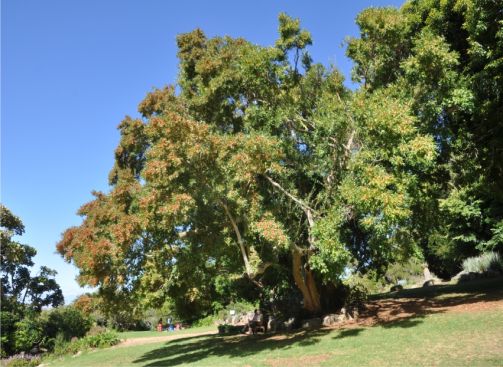
Description
Description
Combretum afrum is a deciduous shrub or small to medium-sized tree, typically growing 5–10 m tall, and may reach up to 15 m, often branching from the base. It has a rounded canopy supported by an often crooked main stem with light grey to greyish-brown bark. Leaves are opposite, leathery in texture, narrowly elliptic, ranging from 40–100 mm long and 10–25 mm wide. The upper leaf surface is dark green and glossy, while the lower surface is paler and often has small hair-tuft domatia. Young leaves may feel slightly velvety, and mature foliage appears drooping. The leaf margins are smooth, slightly undulate and rolled under.
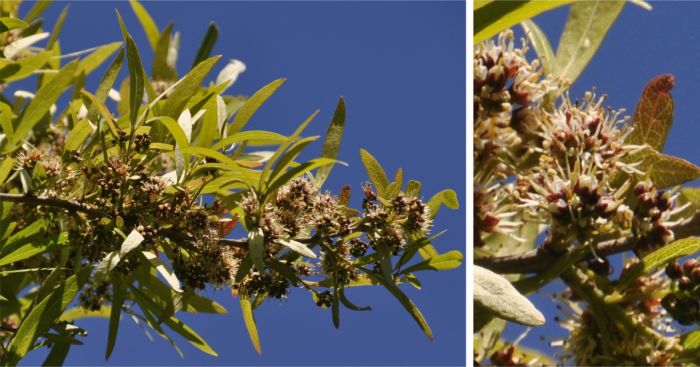
Inflorescences are short, dense clusters, approximately 13 mm in diameter, of cream-white flowers with green to brownish-purple calyces, blooming in spring (from August to November). Flowers are accompanied by shiny, pale bracts, and have a soft, sweet scent.
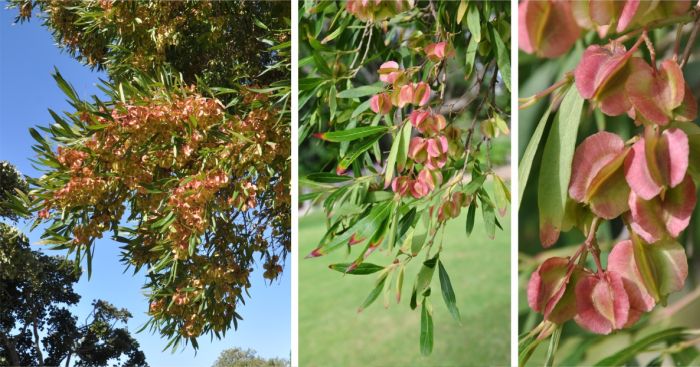
Fruits are distinctive 4-winged capsules, initially lime green and maturing to reddish-brown. They measure approximately 14 × 12 mm and are most conspicuous in late summer and autumn (between January and May), often covering the tree and giving it a striking reddish appearance.
Conservation Status
Status
Least Concern (LC), Combretum afrum is not threatened, according to the Red List of South African Plants.
Distribution and habitat
Distribution description
This species is endemic to South Africa’s Eastern Cape Province. Recorded localities include Kokstad, eMaxesibeni (formerly Mount Ayliff), Komani (Queenstown), Gcuwa (Butterworth), Stutterheim, Fort Hare, Qonce (King William's Town), Seymour, KwaMaqoma (Fort Beaufort), Jansenville, East London, Alicedale, Bathurst, Kariega (Uitenhage) and Gqeberha (Port Elizabeth). It is commonly found along the Umzimvubu River and extends southwest through KwaMaqoma (Fort Beaufort) to the Greater Addo Elephant National Park and eastwards to East London.
Combretum afrum typically inhabits the edges of coastal forests and savanna-like environments with well-drained soils. It prefers riverbanks with sandy or alluvial substrates and may also be found on hillsides and mountain slopes up to 1 100 m in altitude. Associated vegetation types include karoid scrub, evergreen thicket and coastal forest.
Derivation of name and historical aspects
History
The genus Combretum, comprising 287 accepted species of trees, shrubs and climbers, is widely distributed across tropical and southern Africa. The name is from classical Latin, where the Roman naturalist Pliny the Elder (23–79 A.D) used it to describe a climbing plant and it was re-used by the Swedish botanist Pehr Löfling (1729–1756) for this genus. The species name was updated in July 2024 from caffrum to afrum to eliminate botanical terminology with racially insensitive origins. Afrum means ‘of Africa’.
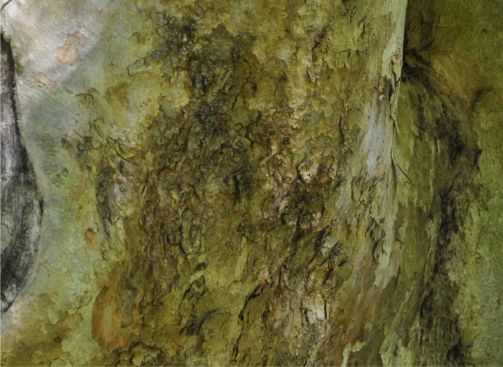
Ecology
Ecology
Flowers are pollinated by insects. The winged fruits are dispersed by wind. Plants are resilient to fire and capable of resprouting after burns.
Uses
Use
Species of Combretum are traditionally used throughout Africa to relieve pain and to treat bacterial infections, and studies validated these uses when they revealed that these species contain compounds that have anti-inflammatory and anti-bacterial activity. Combretum afrum is used in traditional medicine as an all-purpose tonic to promote general healing and well-being. It is also added to bath water to treat body pains. Furthermore, Combretum afrum holds medicinal significance because it was found to contain a potent anti-cancer compound, combretastatin, in its bark, and further research and trials in this regard are being undertaken. In Zulu culture, the root bark is used as a charm to harm an enemy. Additionally, its timber is yellow and dense but not very durable and is used for building poles, rough farm work, and as firewood. It is a good shade tree, suitable for both large and smaller gardens. Honey made from the flowers tastes bitter.
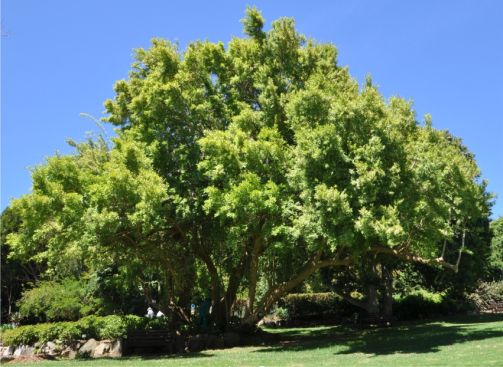
Growing Combretum afrum
Grow
Like many species of Combretum, seed propagation is successful when fruits are harvested at maturity, dried, and the seeds are removed from their winged coverings. Soaking the seeds in water for a few hours prior to sowing enhances germination. Sow seeds in spring to early summer in a well-drained sandy or loamy medium, keep moist and place in a warm, shaded environment. Germination typically begins within one to two weeks and is usually completed within three to four weeks under optimal conditions of moisture and warmth.
Vegetative propagation using semi-hardwood cuttings has also proven to be a reliable method, particularly when cuttings are treated with rooting hormones such as indole-3-butyric acid (IBA) and placed in a moist, well-aerated rooting medium such as a soil–sand or pine bark mix. Under high humidity conditions, rooting generally occurs within three to six weeks. In addition to conventional methods, tissue culture techniques such as micropropagation have been developed for other medicinally important Combretum species, indicating the potential for clonal propagation of C. afrum through in vitro approaches. These propagation strategies provide practical options for the cultivation, conservation, and sustainable use of this species.
References
- Bantho, S. Naidoo, Y., Dewir, Y.H. & Singh. M. 2023. A review on the secretory structures, bioactive compounds and biological activities of selected Combretum species. South African Journal of Botany 158:18-30.
- Boon, R. 2010. Pooley's trees of eastern South Africa, a complete guide. Flora & Fauna Publications Trust, Durban.
- Coates Palgrave, K. 2002. Trees of southern Africa. Struik, Cape Town.
- Ejidike, I.P. et al. 2023. Combretum species around Africa as alternative medicine: Ethnopharmacological and ethnobotanical importance. Journal of Applied Pharmaceutical Science 13(8):12–29.
- Eloff, J.N., Jager, A.K. & Van Staden, J. 2001. The stability and the relationship between anti-inflammatory activity and antibacterial properties of southern African Combretum species. South African Journal of Science 97:291–293.
- Hyde, M.A., Wursten, B.T., Ballings, P. & Coates Palgrave, M. 2024. Genus Combretum. Flora of Zimbabwe. Online. http://www.zimbabweflora.co.zw/speciesdata/genus.php?genus_id=1007.
- Jordaan, M., Van Wyk, A.E. & Maurin, O. 2011. A conspectus of Combretum (Combretaceae) in southern Africa, with taxonomic and nomenclatural notes on species and sections. Bothalia 41(1):135–160.
- Palmer, E. & Pitman, N. 1972. Trees of southern Africa. Balkema, Cape Town.
- Plants of the World Online. Combretum Loefl. https://powo.science.kew.org/taxon/urn:lsid:ipni.org:names:331508-2. Accessed 10 Jun. 2025.
- Raimondo, D., Von Staden, L., Foden, W., Victor, J.E., Helme, N.A., Turner, R.C., Kamundi, D.A. & Manyama, P.A. (eds) 2009. Red list of South African plants. Strelitzia 25. South African National Biodiversity Institute, Pretoria.
- WFO The World Flora Online. Combretum afrum (Eckl. & Zeyh.) Kuntze. http://www.worldfloraonline.org/taxon/wfo-0000616158. Accessed 10 Jun 2025.
- Wikipedia. Pehr Löfling. https://en.wikipedia.org/wiki/Pehr_L%C3%B6fling. Accessed 2 Sep 2025.
Credits
Clara Sitoe and Alice Notten
Kirstenbosch National Botanical Garden
September 2025
Plant Attributes:
Plant Type: Tree
SA Distribution: Eastern Cape
Soil type: Sandy, Loam
Flowering season: Spring
PH: Acid, Neutral
Flower colour: Green, Cream, Yellow
Aspect: Full Sun
Gardening skill: Average
Special Features:
Horticultural zones
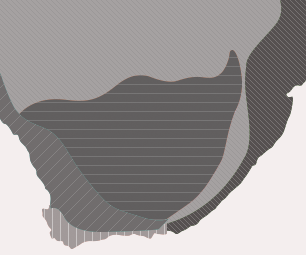







Rate this article
Article well written and informative
Rate this plant
Is this an interesting plant?
Login to add your Comment
Back to topNot registered yet? Click here to register.